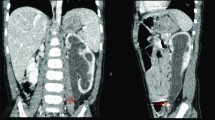Abstract
Congenital midureteral obstruction, caused either by a ureteral valve or stricture, is an exceedingly rare entity. When encountered, it is generally misdiagnosed as either primary megaureter or ureteropelvic junction obstruction, leading to a less than optimal surgical approach. Seven children with midureteral obstruction were seen over the past 17 years. Two of the patients presented with hydronephrosis on prenatal ultrasonography, and five with urinary tract infection. In only three was the diagnosis suspected on intravenous urography and voiding cystourethrography alone. Five of the seven cases had either antegrade or retrograde pyelography, prior to or at the time of their operative procedure, and in four of these a correct diagnosis was made. Notably, in five of the seven cases, recognition of the midureteral lesion prior to the surgical incision allowed the approach to be modified and a more appropriate technique (ureteroureterostomy) to be performed. The etiology of midureteral valve and stricture has been attributed to improper recanalization, insufficient vascular supply, or persistence of ureteral folds. Three of our patients had contralateral renal dysgenesis, suggesting an underlying ureteral bud abnormality.
Similar content being viewed by others
References
Reinberg Y, Aliabadi H, Johnson P, Gonzalez R: Congenital ureteral valves in children: case report and review of the literature.J Pediatr Surg 22:379–381, 1987
Ostling K: The genesis of hydronephrosis. Particularly with regard to changes at the ureteropelvic junction.Acta Chir Scand 86(Suppl):72, 1942
Mering JH, Steel JF, Gittes RF: Congenital ureteral valves.J Urol 107:737–740, 1972
Stephens FD: Primary obstructed megaureter. InCongenital Malformations of the Urinary Tract. New York: Praeger, 1983, pp 267–281
Chwalla R: The process of formation of cystic dilatation of the vesical end of the ureter and of diverticula at the ureteral ostium.Urol Cutan Rev 31:499, 1927
Campbell MF: The dilated ureter in children. A brief consideration of its causes, diagnosis and treatment.Am J Surg 39:438, 1938
Allen TD: Congenital ureteral strictures.Birth Defects 13:17, 1977
Dewolf WC, Fraley EE, Markland C: Congenital hypoplasia of the proximal ureter.J Urol 113:236–237, 1975
Ruano-Gil D, Coca-Payeras A, Tejedo-Mateu A: Obstruction and normal recanalization of the ureter in the human embryo. Its relation to congenital ureteral obstruction.Eur Urol 1:287–293, 1975
Sant GR, Barbalias GA, Klauber GT: Congenital ureteral valves—an abnormality of ureteral embryogenesis?J Urol 133:427–431, 1985
Author information
Authors and Affiliations
Rights and permissions
About this article
Cite this article
Docimo, S.G., Lebowitz, R.L., Retik, A.B. et al. Congenital midureteral obstruction. Urol Radiol 11, 156–160 (1989). https://doi.org/10.1007/BF02926502
Issue Date:
DOI: https://doi.org/10.1007/BF02926502




